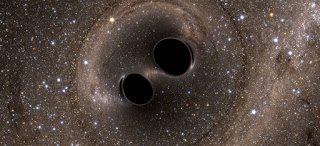TL;DR
- The fabric of the Universe
- Five classical elements - the language of my ancestors
- An orbital acquisition (and to my fellow Filipinos, Mabuhay!)
Current events
After a year-long hiatus, scientists are finally about to restart the two enormous gravitational wave observatories known as LIGO! LIGO was shut down so that scientists could install major hardware upgrades that'll allow them to detect gravitational waves almost daily. So what is LIGO, and why do gravitational waves matter?
Gravitational waves were first detected in 2015, an astounding verification of a prediction Einstein made exactly 100 years prior with his theory of general relativity. Einstein believed the collision of two sufficiently large masses, such as black holes, should cause ripples in spacetime that we might be able to observe. Gravitational waves are crucial to our understanding of the Universe because they provide signals that regular telescopes are unable to see. Think of it this way - if telescopes are our eyes to see the sights of the Universe, gravitational wave detectors are our ears to hear its sounds.
I'm still building out the Further Learning section of Astronomical Returns, but if you want to learn more about how LIGO works, check out a sneak peek here :)
I'm still building out the Further Learning section of Astronomical Returns, but if you want to learn more about how LIGO works, check out a sneak peek here :)
Today I learned
Thus, Mercury is 水星 (shuǐxīng, water star), Venus is 金星 (Jīnxīng, metal star), Mars is 火星 (Huǒxīng, fire star), Jupiter is 木星 (Mùxīng, wood star), and Saturn is 土星 (Tǔxīng, earth star). The word for Earth is 地球 (dìqiú), which literally means ground ball (makes sense right?). To this day, these are the Chinese words for these planets.
This week in space history
I don't often talk about myself on Astronomical Returns, but I'll give a little background because it happens to be relevant today. I'm ethnically Chinese, but my parents were born and raised in the Philippines, so the Today I learned and This week in space history happen to intersect beautifully!
On March 20, 1987, NASA launched an Indonesian communications satellite named Palapa B2-P, but after being in orbit for almost 10 years, it was acquired by the Filipino company Mabuhay Satellite Corporation (Mabuhay is a greeting in Filipino, kind of like saying welcome). The move was mostly symbolic; the Philippines had long been trying to get a satellite, and Philippine President Fidel Ramos wanted one in time for an international forum being hosted that year. Seeing as the satellite, which was renamed Agila-1 (Eagle in Filipino), was deorbited just 3 months later, the investment banker in me cringed hard when I found out the Philippines paid $3 million for that orbital acquisition. They definitely overpaid!
Not until 2016 did the Philippines launch a satellite of their own making, the Diwata-1.
On March 20, 1987, NASA launched an Indonesian communications satellite named Palapa B2-P, but after being in orbit for almost 10 years, it was acquired by the Filipino company Mabuhay Satellite Corporation (Mabuhay is a greeting in Filipino, kind of like saying welcome). The move was mostly symbolic; the Philippines had long been trying to get a satellite, and Philippine President Fidel Ramos wanted one in time for an international forum being hosted that year. Seeing as the satellite, which was renamed Agila-1 (Eagle in Filipino), was deorbited just 3 months later, the investment banker in me cringed hard when I found out the Philippines paid $3 million for that orbital acquisition. They definitely overpaid!
 |
| A Palapa-C satellite, similar to the Palapa B2-P / Agila-1. Credit: Gunter's Space Page |
Not until 2016 did the Philippines launch a satellite of their own making, the Diwata-1.






No comments